This document provides an overview of arrays and pointers in C programming. It defines arrays as a series of elements of the same data type. Arrays can be initialized, accessed using subscripts, and their size determined. Multidimensional arrays contain arrays as elements. Pointers offer an efficient way to work with arrays, as array notation is equivalent to pointer notation. Functions can operate on arrays by passing a pointer to the first element as a parameter.


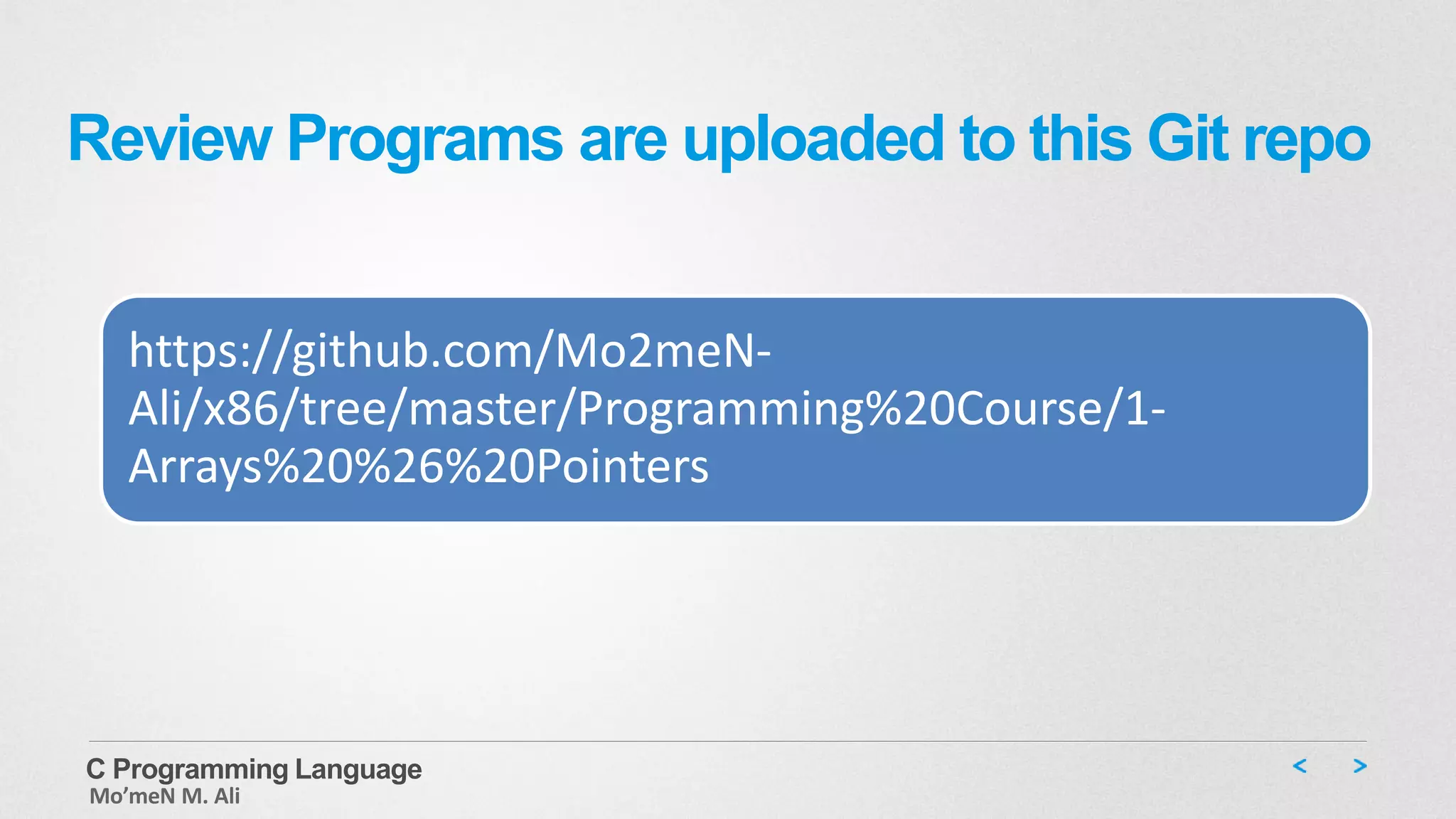
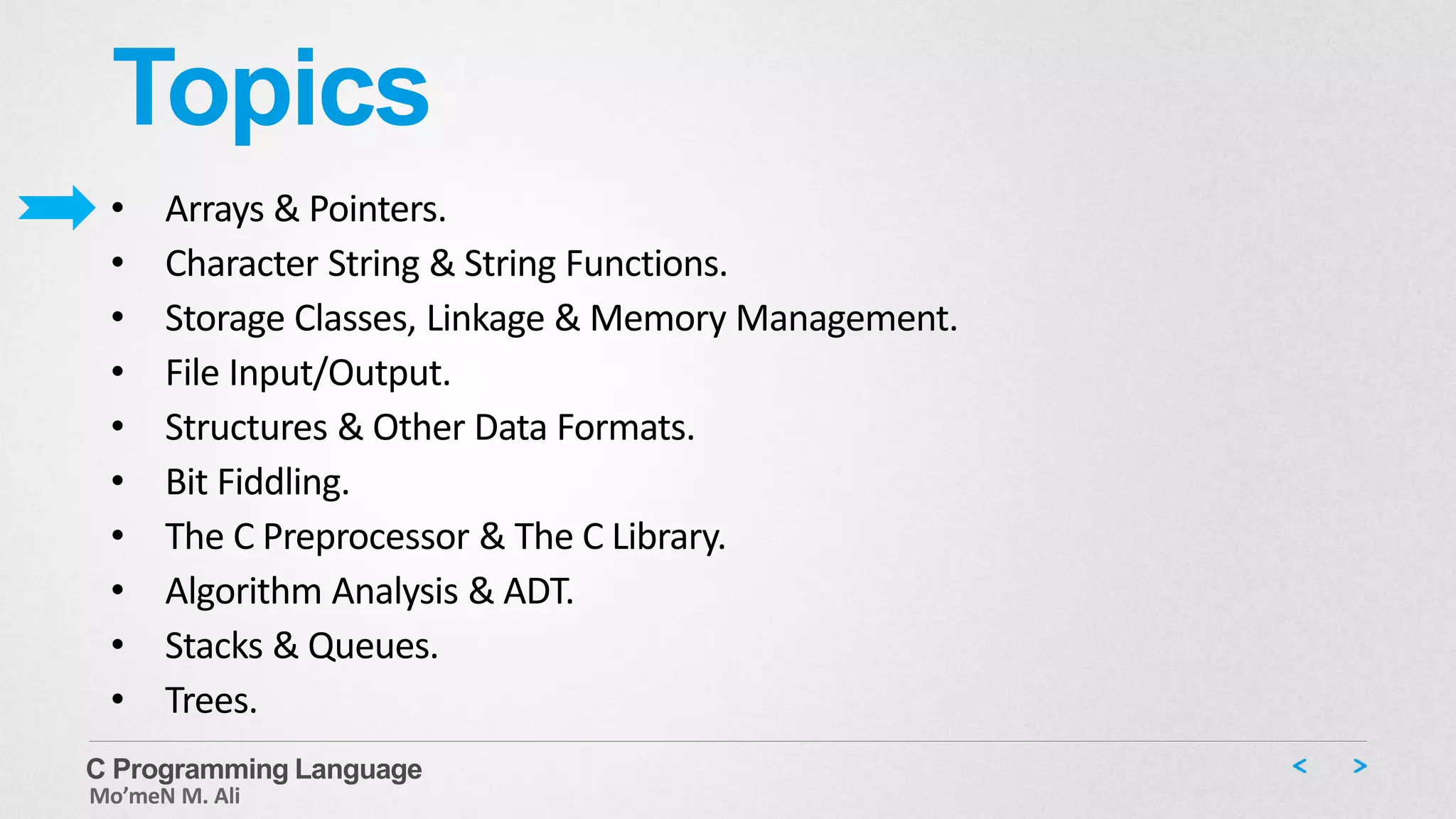

![Arrays • An array is composed of a series of elements of one data type. • An array declaration tells the compiler how many elements the array contains and what the type is for these elements. • To access elements in an array, you identify an individual element by using its subscript number, also called its index,The numbering starts with 0. C Programming Language Mo’meN M. Ali /* some array declarations */ int main(void) { float candy[365]; /* array of 365 floats */ char code[12]; /* array of 12 chars */ int states[50]; /* array of 50 ints */ }](https://image.slidesharecdn.com/cprogrammingdatastructure-arrayspointers-150709231015-lva1-app6892/75/C-programming-data-structure-arrays-pointers-6-2048.jpg)
![C Programming Language Mo’meN M. Ali #include <stdio.h> #define MONTHS 12 int main(void) { int days[MONTHS]= {31,28,31,30,31,30,31,31,30,31,30,31}; int index; for (index = 0; index < MONTHS; index++) printf("Month %d has %2d days.n", index +1, days[index]); return 0; }](https://image.slidesharecdn.com/cprogrammingdatastructure-arrayspointers-150709231015-lva1-app6892/75/C-programming-data-structure-arrays-pointers-7-2048.jpg)
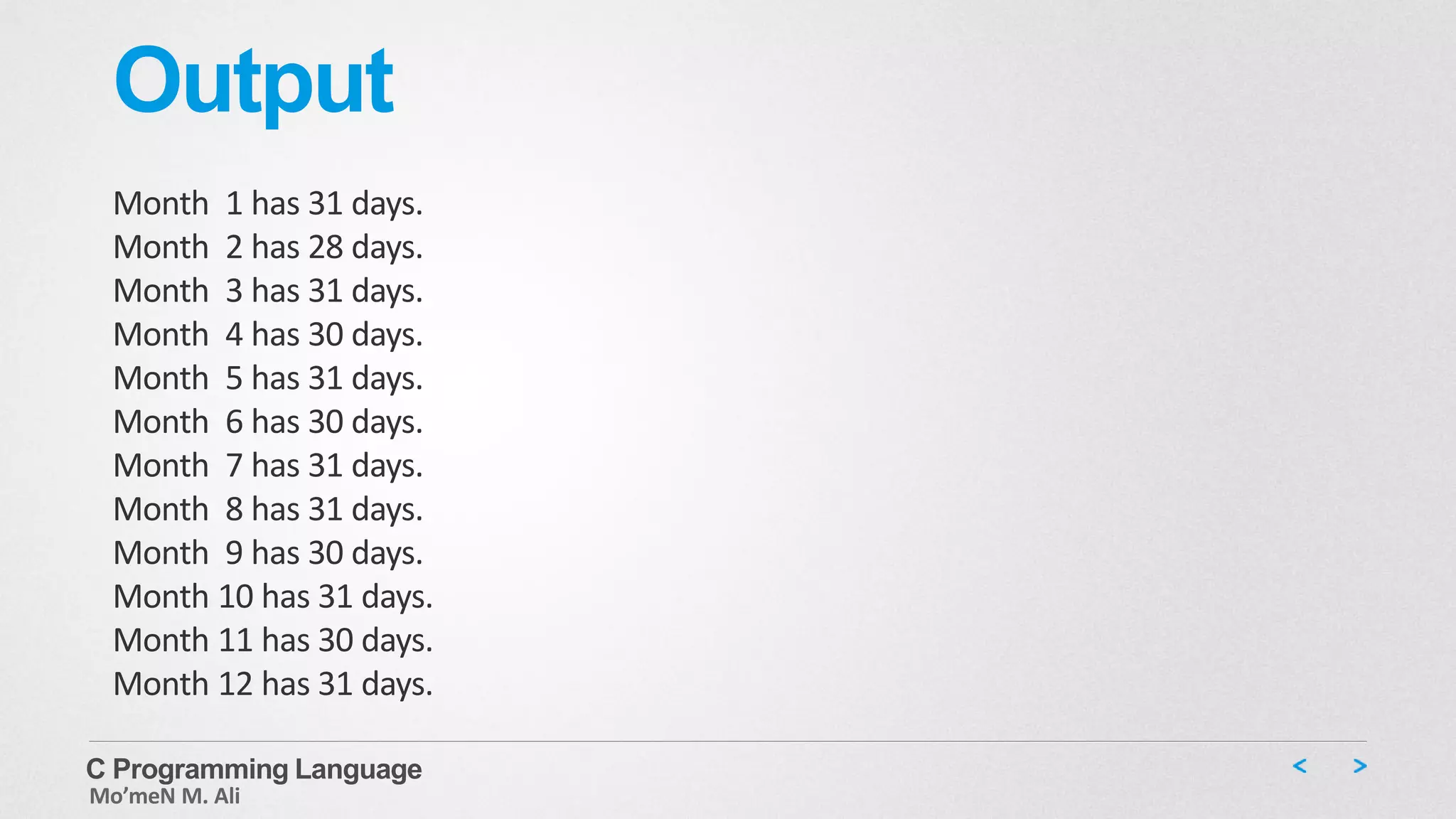
![Entering Data into an Array for ( i = 0 ; i <= 29 ; i++ ) { printf ( "nEnter marks " ) ; scanf ( "%d", &states[i] ) ; } C Programming Language Mo’meN M. Ali Reading data from an array for ( i = 0 ; i <= 29 ; i++ ) sum= sum + marks[i] ;](https://image.slidesharecdn.com/cprogrammingdatastructure-arrayspointers-150709231015-lva1-app6892/75/C-programming-data-structure-arrays-pointers-9-2048.jpg)
![C Programming Language Mo’meN M. Ali #include <stdio.h> #define SIZE 4 int main(void) { int some_data[SIZE]= {1492, 1066}; int i; printf("%2s%14sn", i, some_data[i]); for (i = 0; i < SIZE; i++) printf("%2d%14dn", i, some_data[i]); return 0; }](https://image.slidesharecdn.com/cprogrammingdatastructure-arrayspointers-150709231015-lva1-app6892/75/C-programming-data-structure-arrays-pointers-10-2048.jpg)
![Output i some_data[i] 0 1492 1 1066 2 0 3 0 C Programming Language Mo’meN M. Ali](https://image.slidesharecdn.com/cprogrammingdatastructure-arrayspointers-150709231015-lva1-app6892/75/C-programming-data-structure-arrays-pointers-11-2048.jpg)
![C Programming Language Mo’meN M. Ali #include <stdio.h> int main(void) { const int days[]= {31,28,31,30,31,30,31,31,30,31}; int index; for (index= 0; index < ( sizeof (days) / sizeof (days[0]) ); index++) printf("Month %2d has %d days.n", index +1, days[index]); return 0; }](https://image.slidesharecdn.com/cprogrammingdatastructure-arrayspointers-150709231015-lva1-app6892/75/C-programming-data-structure-arrays-pointers-12-2048.jpg)

![What if you fail to initialize an array? #include <stdio.h> #define SIZE 4 int main(void) { int no_data[SIZE]; /* uninitialized array */ int i; printf("%2s%14sn", "i", "no_data[i]"); for (i = 0; i < SIZE; i++) printf("%2d%14dn", i, no_data[i]); return 0; } C Programming Language Mo’meN M. Ali](https://image.slidesharecdn.com/cprogrammingdatastructure-arrayspointers-150709231015-lva1-app6892/75/C-programming-data-structure-arrays-pointers-14-2048.jpg)
![Output (Your Results may vary) i no_data[i] 0 0 1 4204937 2 4219854 3 2147348480 C Programming Language Mo’meN M. Ali](https://image.slidesharecdn.com/cprogrammingdatastructure-arrayspointers-150709231015-lva1-app6892/75/C-programming-data-structure-arrays-pointers-15-2048.jpg)
![Array Bounds • You have to make sure you use array indices that are within bounds; that is, you have to make sure they have values valid for the array. For instance, suppose you make the following declaration: int doofi[20]; • Then it's your responsibility to make sure the program uses indices only in the range 0 through 19, because the compiler won't check for you. C Programming Language Mo’meN M. Ali](https://image.slidesharecdn.com/cprogrammingdatastructure-arrayspointers-150709231015-lva1-app6892/75/C-programming-data-structure-arrays-pointers-16-2048.jpg)
![C Programming Language Mo’meN M. Ali #include <stdio.h> #define SIZE 4 int main(void) { int value1 = 44; int arr[SIZE]; int value2 = 88; int i; printf("value1 = %d, value2 = %dn", value1, value2); for (i = -1; i <= SIZE; i++) arr[i] = 2 * i + 1; for (i = -1; i < 7; i++) printf("%2d %dn", i , arr[i]); printf("value1 = %d, value2 = %dn", value1, value2); return 0; }](https://image.slidesharecdn.com/cprogrammingdatastructure-arrayspointers-150709231015-lva1-app6892/75/C-programming-data-structure-arrays-pointers-17-2048.jpg)
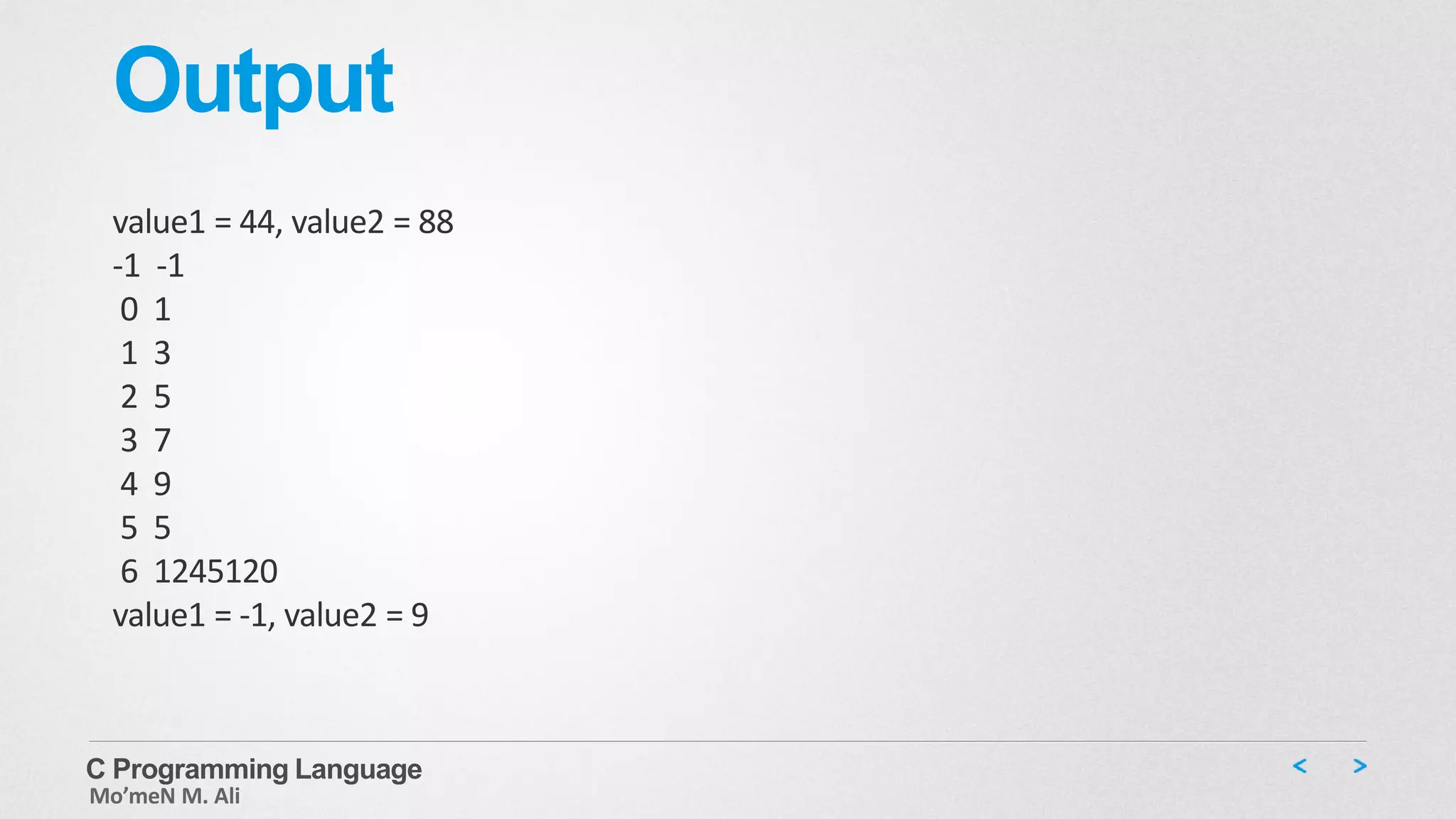
![Designated Initializers (C99) • C99 has added a new capability designated initializers. This feature allows you to pick and choose which elements are initialized. Suppose, for example, that you just want to initialize the last element in an array. With traditional C initialization syntax, you also have to initialize every element preceding the last one: int arr[6] = {0,0,0,0,0,212}; // traditional syntax • With C99, you can use an index in brackets in the initialization list to specify a particular element: int arr[6] = {[5] = 212}; // initialize arr[5] to 212 C Programming Language Mo’meN M. Ali](https://image.slidesharecdn.com/cprogrammingdatastructure-arrayspointers-150709231015-lva1-app6892/75/C-programming-data-structure-arrays-pointers-19-2048.jpg)
![C Programming Language Mo’meN M. Ali // designate.c -- use designated initializers #include <stdio.h> #define MONTHS 12 int main(void) { int days[MONTHS] = {31,28, [4] = 31,30,31, [1] = 29}; int i; for (i = 0; i < MONTHS; i++) printf("%2d %dn", i + 1, days[i]); return 0; }](https://image.slidesharecdn.com/cprogrammingdatastructure-arrayspointers-150709231015-lva1-app6892/75/C-programming-data-structure-arrays-pointers-20-2048.jpg)
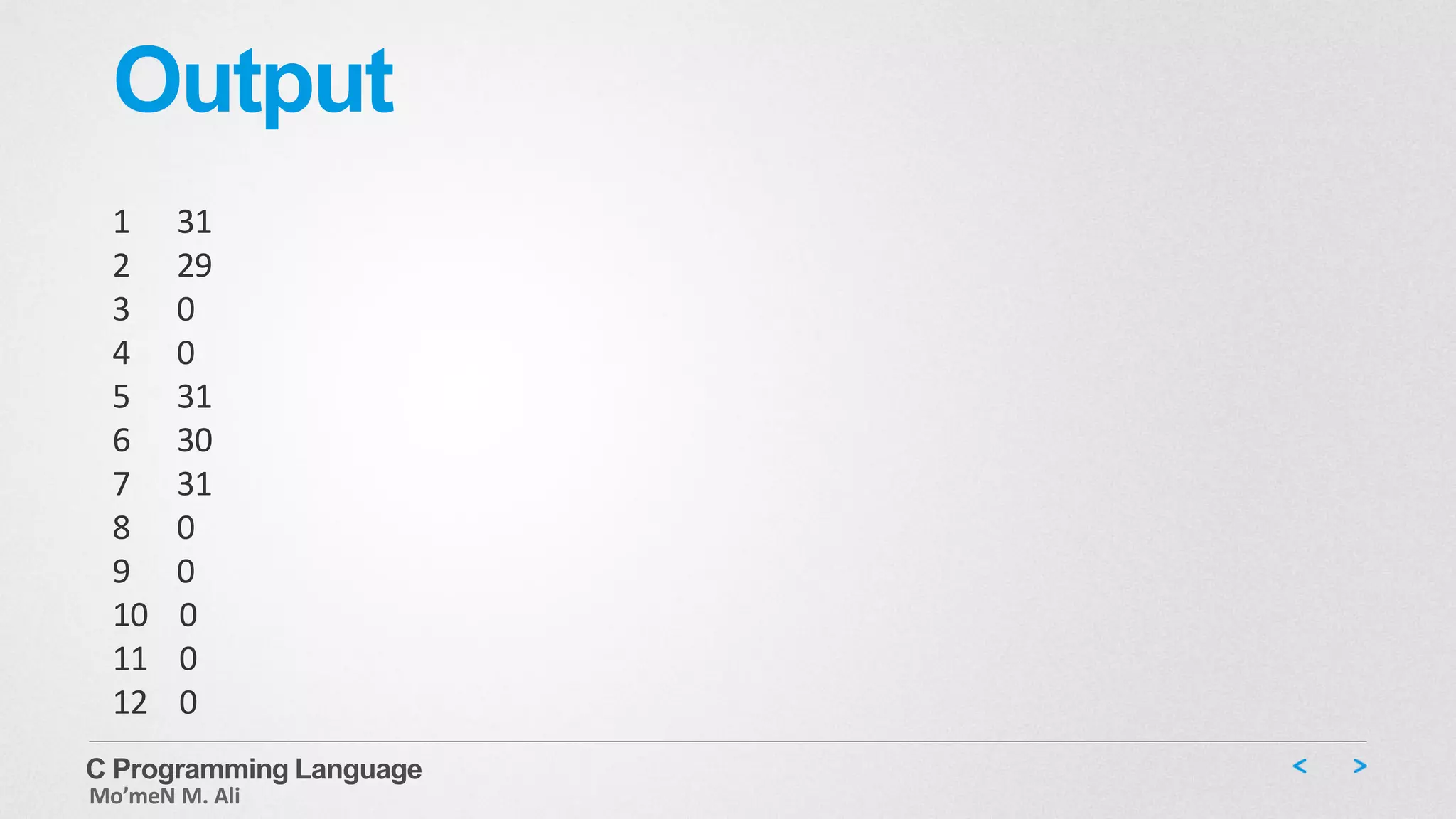
![Suppose you don’t specify the array size? int stuff[] = {1, [6] = 23}; // what happens? int staff[] = {1, [6] = 4, 9, 10}; // what happens? • The compiler will make the array big enough to accommodate the initialization values. So stuff will have seven elements, numbered 0-6, and staff will have two more elements, or 9. C Programming Language Mo’meN M. Ali](https://image.slidesharecdn.com/cprogrammingdatastructure-arrayspointers-150709231015-lva1-app6892/75/C-programming-data-structure-arrays-pointers-22-2048.jpg)
![Specifying an Array Size #define SIZE 4 int arr[SIZE]; // symbolic integer constant double lots[144]; // literal integer constant int n = 5; int m = 8; float a1[5]; // yes float a2[5*2 + 1]; // yes float a3[sizeof(int) + 1]; // yes float a4[-4]; // no, size must be > 0 float a5[0]; // no, size must be > 0 float a6[2.5]; // no, size must be an integer float a7[(int)2.5]; // yes, typecast float to int constant float a8[n]; // not allowed before C99 float a9[m]; // not allowed before C99 C Programming Language Mo’meN M. Ali](https://image.slidesharecdn.com/cprogrammingdatastructure-arrayspointers-150709231015-lva1-app6892/75/C-programming-data-structure-arrays-pointers-23-2048.jpg)
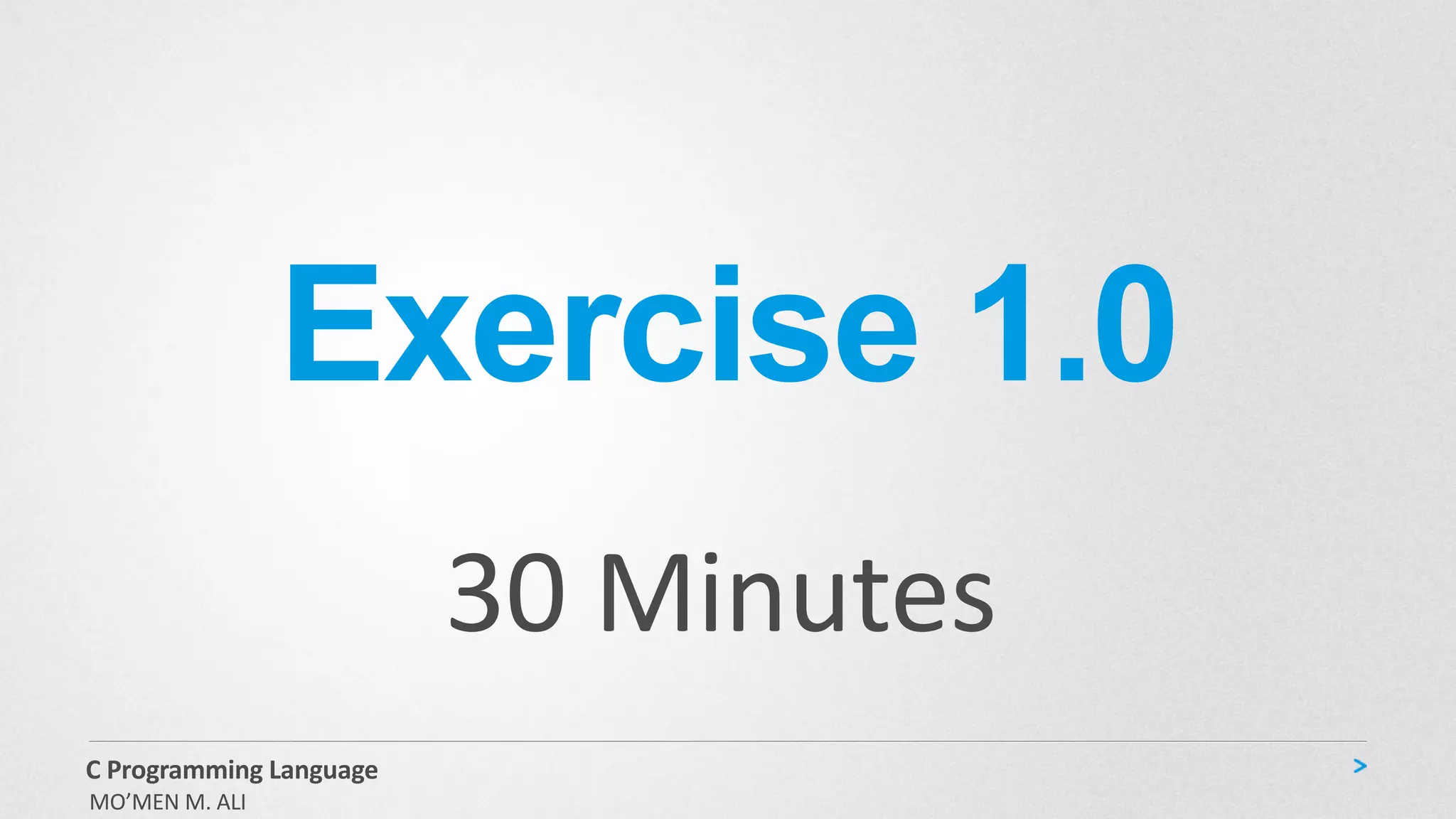
![Multidimensional arrays • A multidimensional array is an array which every element in it is an array. float rain[5] [12]; // an array of 12 floats • This tells us that each element is of type float[12]; that is, each of the five elements of rain is, in itself, an array of 12 float values. C Programming Language Mo’meN M. Ali](https://image.slidesharecdn.com/cprogrammingdatastructure-arrayspointers-150709231015-lva1-app6892/75/C-programming-data-structure-arrays-pointers-25-2048.jpg)
![Initializing a two-dimensional array #define MONTHS 12 // number of months in a year #define YEARS 5 // number of years of data const float rain[YEARS][MONTHS] = { {4.3,4.3,4.3,3.0,2.0,1.2,0.2,0.2,0.4,2.4,3.5,6.6}, // Row 0 (rain[0]) {8.5,8.2,1.2,1.6,2.4,0.0,5.2,0.9,0.3,0.9,1.4,7.3}, // Row 1 (rain[1]) {9.1,8.5,6.7,4.3,2.1,0.8,0.2,0.2,1.1,2.3,6.1,8.4}, // Row 2 (rain[2]) {7.2,9.9,8.4,3.3,1.2,0.8,0.4,0.0,0.6,1.7,4.3,6.2}, // Row 3 (rain[3]) {7.6,5.6,3.8,2.8,3.8,0.2,0.0,0.0,0.0,1.3,2.6,5.2} // Row 4 (rain[4]) }; Review Program: rain C Programming Language Mo’meN M. Ali](https://image.slidesharecdn.com/cprogrammingdatastructure-arrayspointers-150709231015-lva1-app6892/75/C-programming-data-structure-arrays-pointers-26-2048.jpg)
![Pointers And Arrays • Pointers offer an efficient way to deal with arrays. Indeed. • Array notation is simply a disguised use of pointers. 1. date == &date[0]; // name of array is the address of the first element 2. dates +2 == &date[2] /* same address */ 3. *(dates + 2) == dates[2] /* same value */ 4. *(dates +2) /* value of the 3rd element of dates */ 5. *dates +2 /* 2 added to the value of the 1st element */ C Programming Language Mo’meN M. Ali](https://image.slidesharecdn.com/cprogrammingdatastructure-arrayspointers-150709231015-lva1-app6892/75/C-programming-data-structure-arrays-pointers-27-2048.jpg)
![C Programming Language Mo’meN M. Ali #include <stdio.h> #define SIZE 4 int main(void) { short dates [SIZE]; short * pti; short index; double bills[SIZE]; double * ptf; pti = dates; // assign address of array to pointer ptf = bills; printf("%23s %15sn", "short", "double"); for (index = 0; index < SIZE; index ++) printf("pointers + %d: %10p %10pn", index, pti + index, ptf + index); return 0; }](https://image.slidesharecdn.com/cprogrammingdatastructure-arrayspointers-150709231015-lva1-app6892/75/C-programming-data-structure-arrays-pointers-28-2048.jpg)
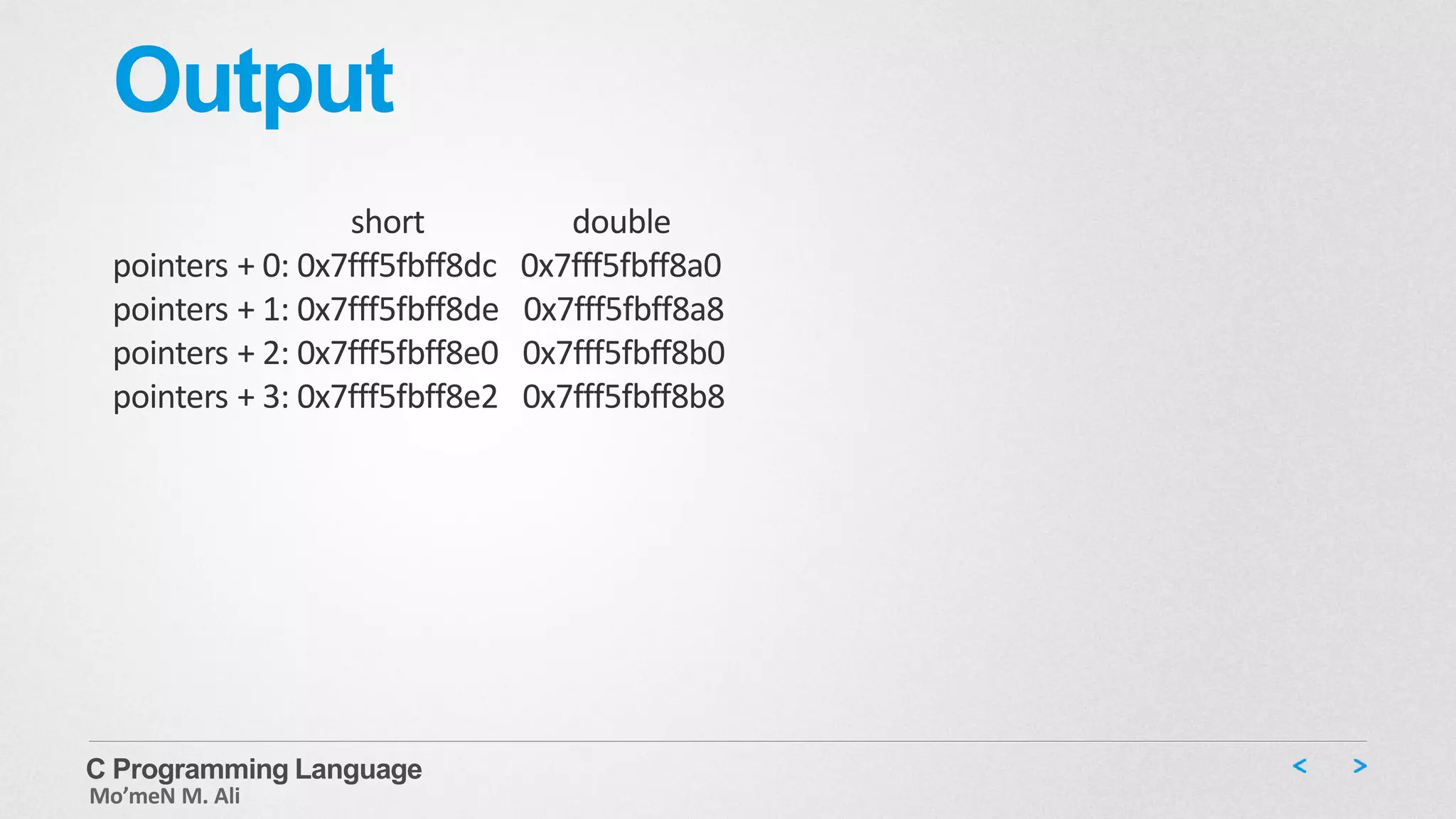
![C Programming Language Mo’meN M. Ali /* day_mon3.c -- uses pointer notation */ #include <stdio.h> #define MONTHS 12 int main(void) { int days[MONTHS] = {31,28,31,30,31,30,31,31,30,31,30,31}; int index; for (index = 0; index < MONTHS; index++) printf("Month %2d has %d days.n", index +1, *(days + index)); // same as days[index] return 0; }](https://image.slidesharecdn.com/cprogrammingdatastructure-arrayspointers-150709231015-lva1-app6892/75/C-programming-data-structure-arrays-pointers-30-2048.jpg)

![C Programming Language Mo’meN M. Ali int sum(int * ar) // corresponding definition { int i; int total = 0; for( i = 0; i < 10; i++) // assume 10 elements total += ar[i]; // ar[i] the same as *(ar + i) return total; } int sum(int * ar, int n) // more general approach { int i; int total = 0; for( i = 0; i < n; i++) // use n elements total += ar[i]; // ar[i] the same as *(ar + i) return total; }](https://image.slidesharecdn.com/cprogrammingdatastructure-arrayspointers-150709231015-lva1-app6892/75/C-programming-data-structure-arrays-pointers-32-2048.jpg)
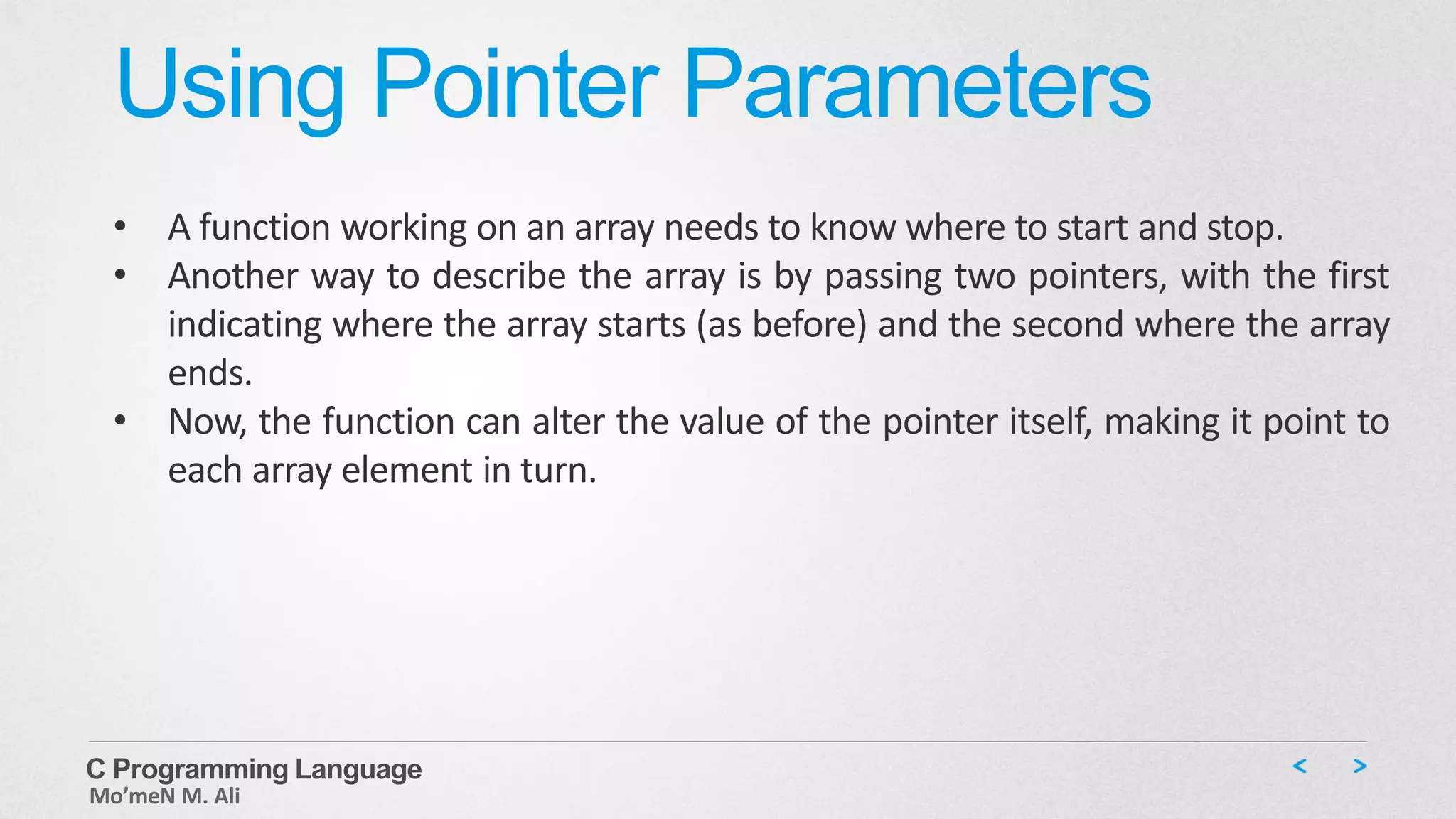
![Arrays as Arguments • Because the name of an array is the address of the first element, an actual argument of an array name requires that the matching formal argument be a pointer. Also, C interprets int ar[] to mean the same as int * ar. • All four of the following prototypes are equivalent: int sum(int *ar, int n); int sum(int *, int); int sum(int ar[], int n); int sum(int [], int); Review Program: Array as arguments C Programming Language Mo’meN M. Ali](https://image.slidesharecdn.com/cprogrammingdatastructure-arrayspointers-150709231015-lva1-app6892/75/C-programming-data-structure-arrays-pointers-34-2048.jpg)
![Pointer Operations Review Program: PointerOperations • Assignment— You can assign an address to a pointer. The assigned value can be, for example, an array name, a variable preceded by address operator ( & ), or another second pointer. • Value finding (dereferencing)— The * operator gives the value stored in the pointed-to location. Therefore, *ptr1 is initially 100 , the value stored at location 0x7fff5fbff8d0 . • Taking a pointer address— Like all variables, a pointer variable has an address and a value. The & operator tells you where the pointer itself is stored. • Adding an integer to a pointer— You can use the + operator to add an integer to a pointer or a pointer to an integer. In either case, the integer is multiplied by the number of bytes in the pointed-to type, and the result is added to the original address. This makes ptr1 + 4 the same as &urn[4] . C Programming Language Mo’meN M. Ali](https://image.slidesharecdn.com/cprogrammingdatastructure-arrayspointers-150709231015-lva1-app6892/75/C-programming-data-structure-arrays-pointers-35-2048.jpg)
![• Incrementing a pointer— Incrementing a pointer to an array element makes it move to the next element of the array. Therefore, ptr1++ increases the numerical value of ptr1 by 4 (4 bytes per int on our system) and makes ptr1 point to urn[1]. • Subtracting an integer from a pointer— You can use the - operator to subtract an integer from a pointer; the pointer has to be the first operand and the integer value the second operand. The integer is multiplied by the number of bytes in the pointed-to type, and the result is subtracted from the original address. • Decrementing a pointer— Of course, you can also decrement a pointer. In this example, decrementing ptr2 makes it point to the second array element instead of the third. Note that you can use both the prefix and postfix forms of the increment and decrement operators. • Differencing— You can find the difference between two pointers. Normally, you do this for two pointers to elements that are in the same array to find out how far apart the elements are. The result is in the same units as the type size. • Comparisons— You can use the relational operators to compare the values of two pointers, provided the pointers are of the same type. C Programming Language Mo’meN M. Ali](https://image.slidesharecdn.com/cprogrammingdatastructure-arrayspointers-150709231015-lva1-app6892/75/C-programming-data-structure-arrays-pointers-36-2048.jpg)
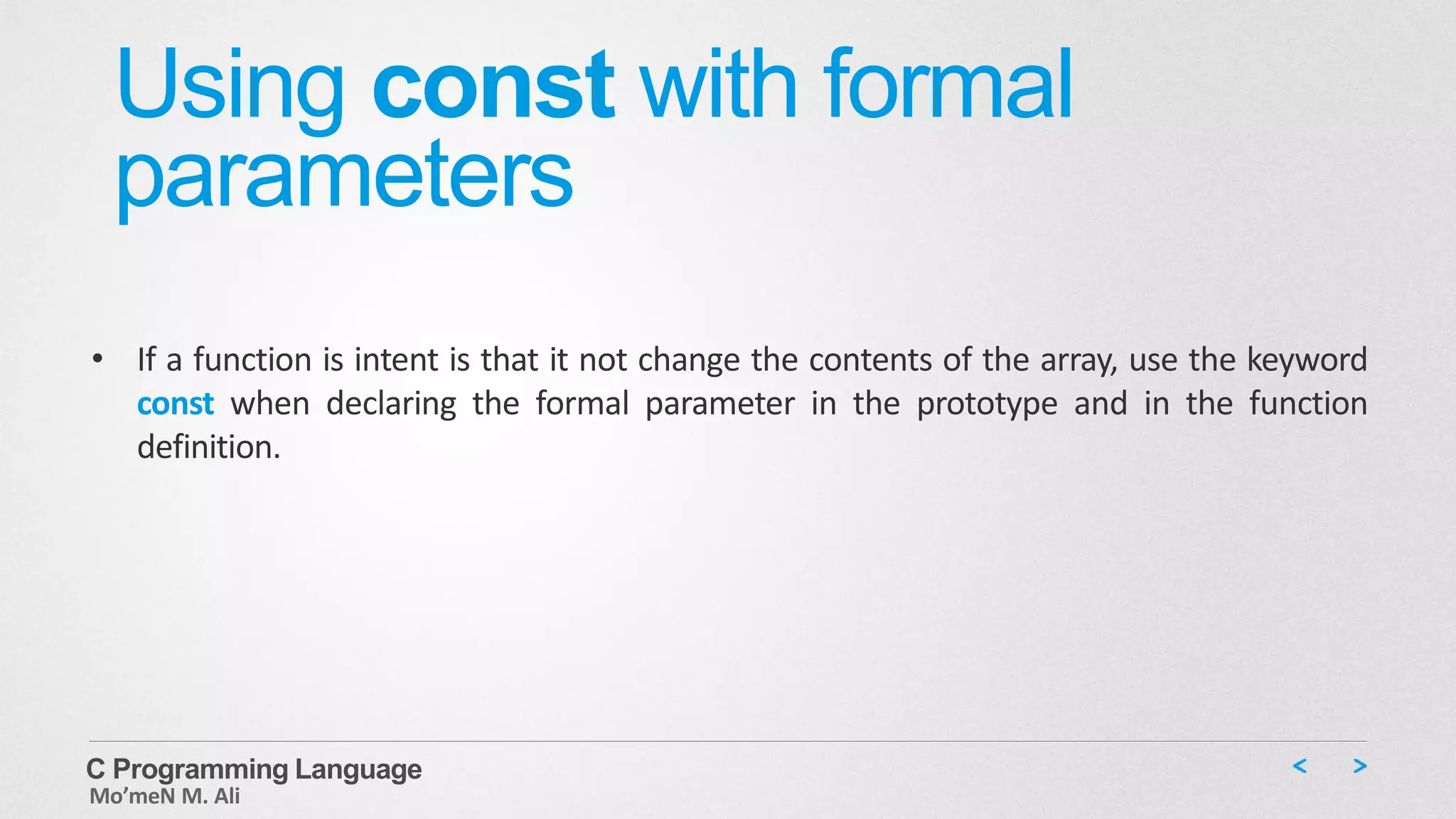
![Pointers to multidimensional Arrays • Since 2D-Arrays are Arrays of arrays, therefore we need a pointer-to-array instead of a pointer-to-element. int (* pz)[2]; // pz points to an array of 2 ints. (Can be used as 2D // Array pointer). int * pax[2]; // pax is an array of two pointers-to-int (Can no be used as 2D // Array Pointer). C Programming Language Mo’meN M. Ali](https://image.slidesharecdn.com/cprogrammingdatastructure-arrayspointers-150709231015-lva1-app6892/75/C-programming-data-structure-arrays-pointers-38-2048.jpg)
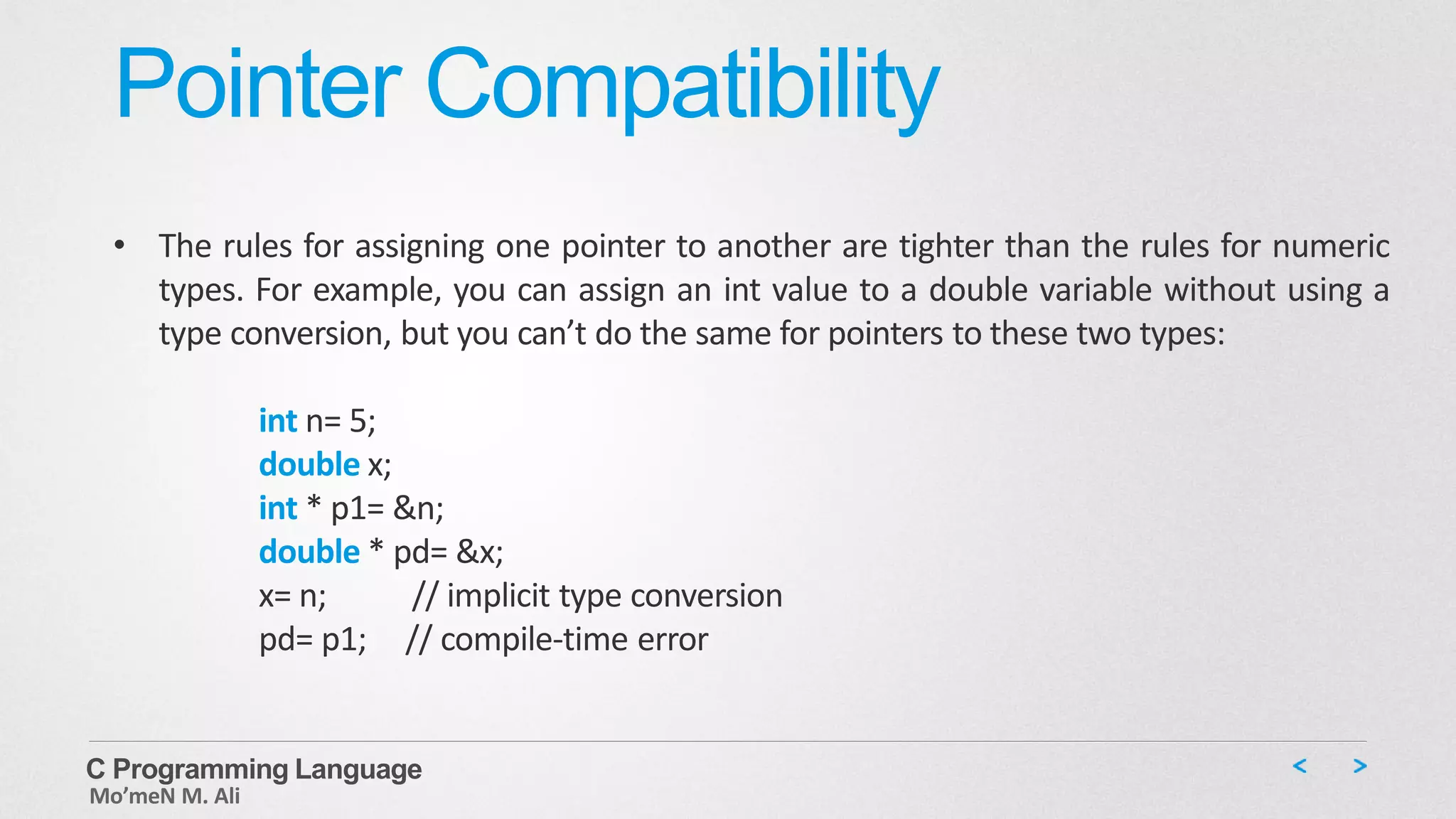
![int * pt; int (*pa)[3]; int ar1[2][3]; int ar2[3][2]; int **p2; // a pointer to a pointer pt = &ar1[0][0]; // both pointer-to-int pt = ar1[0]; // both pointer-to-int pt = ar1; // not valid pa = ar1; // both pointer-to-int[3] pa = ar2; // not valid p2 = &pt; // both pointer-to-int * *p2 = ar2[0]; // both pointer-to-int p2 = ar2; // not valid Review Program: Pointers and 2D-Arrays C Programming Language Mo’meN M. Ali](https://image.slidesharecdn.com/cprogrammingdatastructure-arrayspointers-150709231015-lva1-app6892/75/C-programming-data-structure-arrays-pointers-40-2048.jpg)
![Functions and multidimensional arrays • If you want to write functions that process two-dimensional arrays, you need to understand pointers well enough to make the proper declarations for function arguments. In the function body itself, you can usually get by with array notation. int junk[3][4] = { {2,4,5,8}, {3,5,6,9}, {12,10,8,6} }; int i, j; int total = 0; for (i = 0; i < 3 ; i++) total += sum(junk[i], 4); // junk[i] -- one-dimensional array C Programming Language Mo’meN M. Ali](https://image.slidesharecdn.com/cprogrammingdatastructure-arrayspointers-150709231015-lva1-app6892/75/C-programming-data-structure-arrays-pointers-41-2048.jpg)
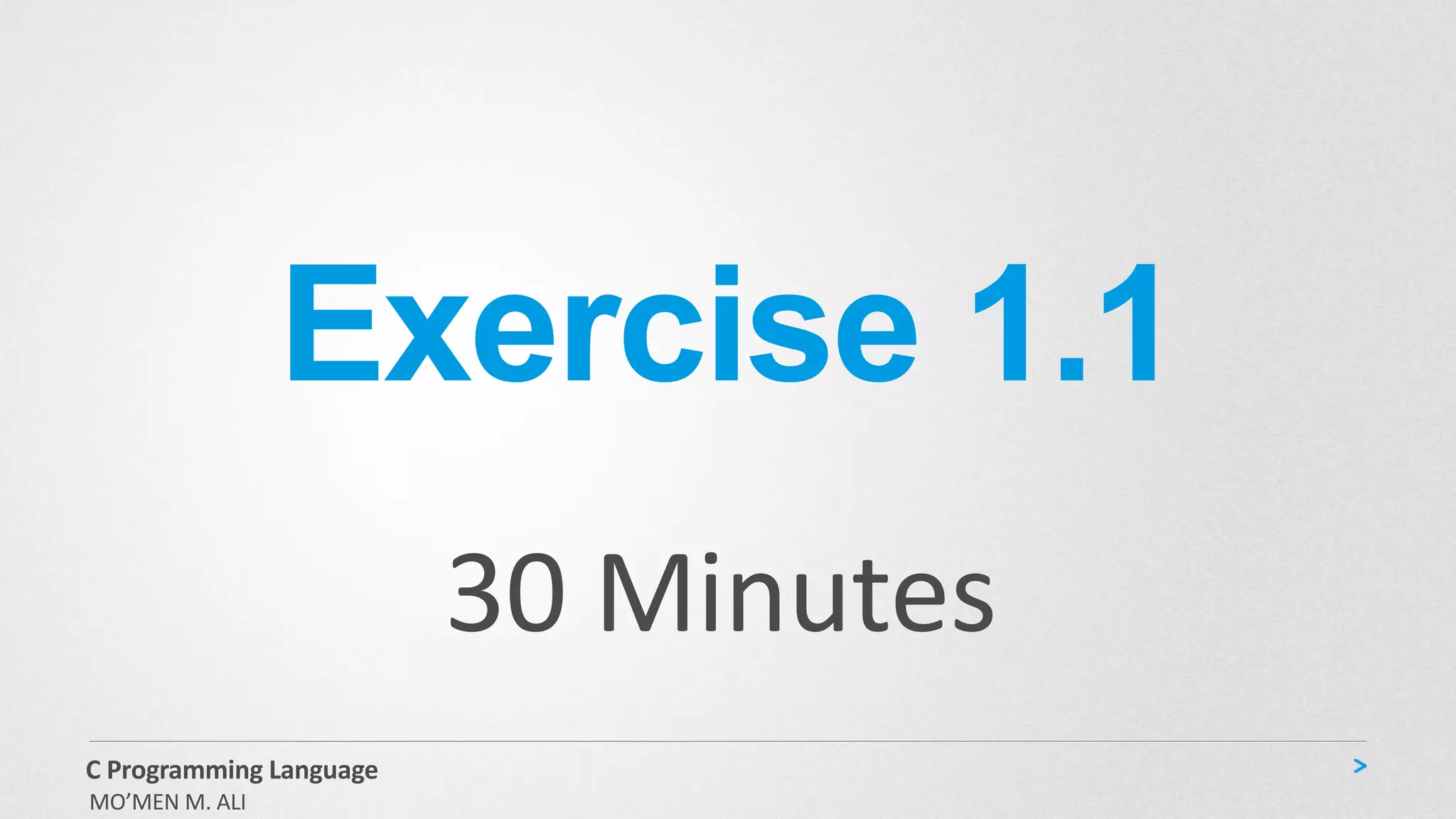
![Variable-length arrays (VLAs) • You may have noticed that you can not use a variable size multidimensional array as an argument, that is because you always have to use a constant columns. Well VLAs is the C99 way to solve this problem. You can use VLAs to pass a variable length multidimensional array. int sum2d(int rows, int cols, int ar[rows][cols]); // array a VLA int sum2d(int, int, int ar[*][*]); // array a VLA, names omitted • rows and cols are two variable arguments that can be passed at run-time. • rows and cols must be define before the array. int sum2d(int ar[rows][cols], int rows, int cols); // invalid order Review Program: Functions usingVLAs C Programming Language Mo’meN M. Ali](https://image.slidesharecdn.com/cprogrammingdatastructure-arrayspointers-150709231015-lva1-app6892/75/C-programming-data-structure-arrays-pointers-43-2048.jpg)
![More dimensions • Everything we have said about two-dimensional arrays can be generalized to three-dimensional arrays and further. You can declare a three- dimensional array this way: int box[10][20][30]; • You can visualize a one-dimensional array as a row of data, a two- dimensional array as a table of data, and a three-dimensional array as a stack of data tables. For example, you can visualize the box array as 10 two-dimensional arrays (each 20×30) stacked atop each other. C Programming Language Mo’meN M. Ali](https://image.slidesharecdn.com/cprogrammingdatastructure-arrayspointers-150709231015-lva1-app6892/75/C-programming-data-structure-arrays-pointers-44-2048.jpg)

